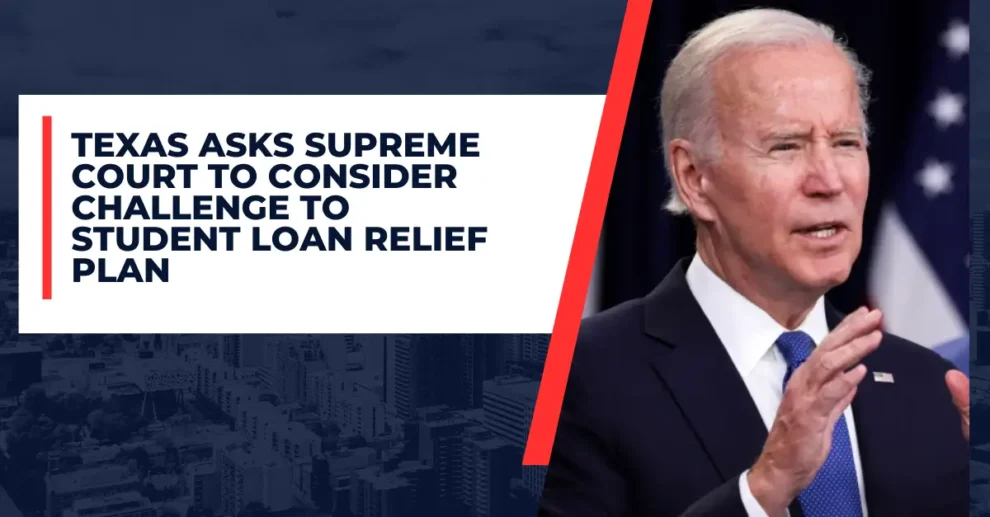Texas informed the Supreme Court on August 10 that, notwithstanding a federal appeals court’s blocking of several important aspects of the U.S. Department of Education’s planned student loan relief plan, it intends to proceed with a pending emergency application to suspend the plan.
On July 5, Texas, South Carolina, and Alaska submitted a motion to the Supreme Court in the intricate and hotly contested issue, requesting that the court put an end to the department’s SAVE plan. The anticipated cost of the idea, which would eliminate some student loan debt, is $475 billion. Alaska v. Department of Education is the case name.
First put up by Education Secretary Miguel Cardona in August 2022, the SAVE plan would expedite loan forgiveness for some students and reduce monthly payments for millions of qualifying borrowers. The abbreviation for Savings on a Valuable Education is SAVE.
Eight million debtors are said to have registered for the program. When the Supreme Court overturned President Joe Biden’s prior $400 billion plan for student loan forgiveness in Biden v. Nebraska in June 2023, the SAVE plan was still in the planning stages.
Parts of the SAVE plan were temporarily put on hold while the legal dispute over it was being handled by the U.S. Court of Appeals for the Eighth Circuit on August 9. The states contesting it—Missouri, Arkansas, Florida, Georgia, North Dakota, Ohio, and Oklahoma—would probably be able to demonstrate that the plan is in violation of the substantial questions doctrine, the circuit court determined.
According to the big questions concept, courts need to assume that Congress does not assign significant policy questions to government agencies.
A clause that would have stopped interest from collecting on student loans, stopped the federal government from forgiving principle or interest on outstanding loans, and blocked a provision that would have allowed students to make extremely low or no monthly payments based on their income are all blocked by the circuit court’s order.
“I strongly disagree with the Eighth Circuit’s decision blocking our Administration’s SAVE plan,” Cardona wrote on X a few hours after the ruling.
The information you actually want to know, though, is this: borrowers who are presently enrolled in SAVE will be put into an interest-free forbearance. In the upcoming days, [the Department of Education] will offer updates.
Prior to that, on June 24, two federal district judges temporarily banned portions of the SAVE plan as the cases proceeded through the legal system at the request of two coalitions of Republican-led states that filed separate complaints. Both of them discovered that the federal Higher Education Act does not give the department the jurisdiction to implement specific parts of the plan.
Although elements of the plan that were already in place may be carried out, U.S. District Judge Daniel Crabtree of Kansas banned portions that were set to go into force on July 1. One of those clauses that was blocked would have reduced payments from 10% of the borrower’s income to 5%.
Prior to this, on June 7, Crabtree decided that because Alaska, South Carolina, and Texas had demonstrated the SAVE plan would negatively impact state revenue, they “just barely” had legal standing to oppose it.
Standing is the legal term for the ability to file a lawsuit. To support their involvement in a lawsuit, the parties must show that they have a sufficiently close relationship to the action that is being complained of.
Alabama, Idaho, Iowa, Kansas, Louisiana, Montana, Nebraska, and Utah were determined to have no standing and could not proceed with the case by Crabtree in the same order.
Student loan forgiveness was prevented by the order issued by U.S. District Judge John Ross of Missouri.
The U.S. Court of Appeals for the Tenth Circuit temporarily suspended Crabtree’s ruling on June 30 and permitted the start of income-contingent repayments. For the duration that the appeal is underway, the stay will be in place.
The state received much of what it sought from the Eighth Circuit’s injunction stopping parts of the SAVE plan, but some questions remained, according to a filing made by Texas Solicitor General Aaron Nielson to the Supreme Court on August 10.












Add Comment